One,
Gas Adsorption Method
1. Test Principle:
The pore volume is determined through low-temperature nitrogen adsorption, which helps calculate the porosity of the material. This method is effective for pores smaller than 200 nm but cannot analyze larger pores, making it unsuitable for many membrane applications.
2. Pore Size Testing Range:
0.35–500 nm
3. Defects in Membrane Material Pore Size Testing:
This technique covers a pore size range of 0.35–500 nm. It is not suitable for testing micrometer-sized pores. The critical parameter for membranes is the throat diameter of through-holes—the narrowest point of the hole. However, nitrogen adsorption cannot distinguish between through-holes and blind holes, leading to significant errors in pore size measurements.
4. Method Schematic:
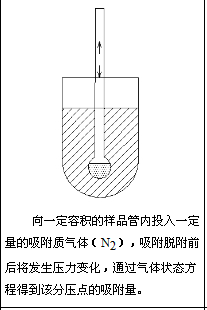
Second, Mercury Intrusion Method
1. Test Principle:
Mercury is forced into a dried porous sample under external pressure. The volume of mercury that infiltrates is measured as a function of pressure, allowing the calculation of pore size distribution. This method can also measure U-shaped pores, but the results may not be very accurate. For small pores (below 100 nm), very high pressure (20 MPa or more) is required, which can damage the sample and cause structural deformation, leading to inaccurate results.
2. Pore Size Testing Range:
50 nm – 500 µm
3. Defects in Membrane Material Pore Size Testing:
(1) The pore size range is from 50 nm to 500 µm. To test smaller pores (under 100 nm), extremely high pressure is needed, which may not be acceptable for most organic materials. High pressure can deform or collapse the pore structure, causing deviations from theoretical values. Unlike the bubble point method, which applies lower pressure, this technique has limitations. (3) Like nitrogen adsorption, mercury intrusion cannot differentiate between through-holes and blind holes, so it cannot accurately characterize the throat diameter of pores.
4. Test Schematic
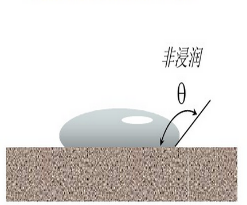

Mercury is pressed into the pores between particles, and the pore size invaded by mercury depends on the applied pressure. On the right side, mercury is injected into the sample through a metal jacket and electrode cap (plate electrode). The volume of mercury discharged is then measured.
Third, Bubble Point Method
1. Test Principle:
When a channel is filled with a wetting liquid, gas must overcome surface tension to pass through. The smaller the pore, the higher the required pressure. By comparing the pressure and flow rate in dry and wet states, the pore size distribution can be calculated using a mathematical model.
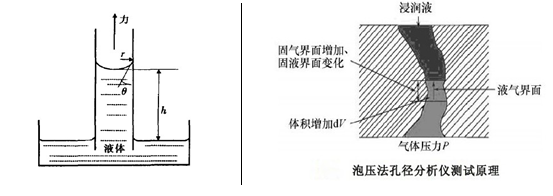
2. Pore Size Testing Range:
20 nm – 500 µm
3. Gas-Liquid Displacement Method:
Due to the high interfacial tension between gas and liquid, measuring smaller pores requires higher gas pressure, which can lead to issues like leakage, sample deformation, or pressure drop. One drawback of the bubble point method is its limited ability to measure very small pore sizes in membrane materials.
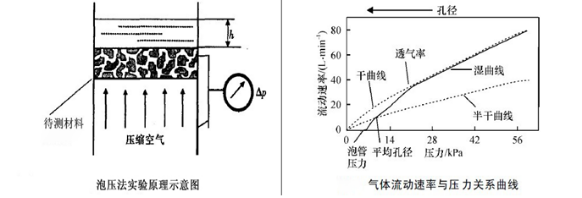
4. Instrument Test Report Screenshot

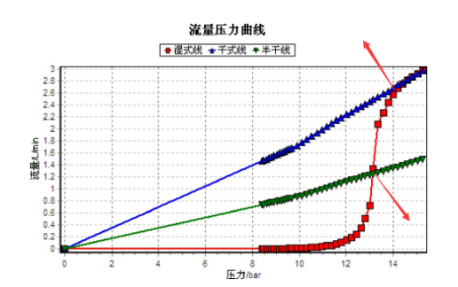
5. Instrument Picture
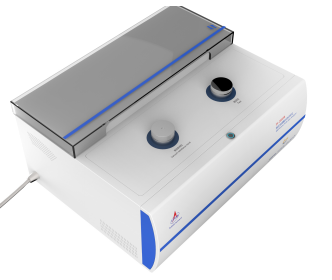
Fourth, Cross-Flow Filtration
1. Test Principle:
A spherical particle suspension is used as a medium. The sample undergoes cross-flow filtration, and the pore size distribution is calculated by comparing the particle size of the original suspension and the permeate. The diameter of the particles in the permeate corresponds to the pore size of the membrane.
Fifth, Liquid-Liquid Displacement
1. Test Principle:
Similar to the bubble point method, this technique measures pore throats. Instead of gas, an immiscible liquid is used as the displacing agent.
2. Pore Size Testing Range:
10 nm – 200 µm
3. Advantages and Disadvantages of Membrane Material Pore Size Testing:
Because of the low interfacial tension between liquids, only a small pressure is needed to measure large pores, but this leads to higher measurement errors. The optimal range is 10 nm to 200 µm.
Bubble Pressure Method (Gas-Liquid Displacement): Pressure-Pore Diameter Relationship
According to the formula: D = 4 γCos θ / ΔP, the calculations are as follows:
| Pore Diameter (µm) | Infusion: Water | γ = 72.75 mN/m | Displacement Solution: Poropil | γ = 16 mN/m |
| 0.005 | 416.13 | 91.52 | ||
| 0.01 | 208.07 | 45.76 | ||
| 0.05 | 41.61 | 9.15 | ||
| 0.1 | 20.81 | 4.58 | ||
| 0.5 | 4.16 | 0.915 | ||
| 1 | 2.08 | 0.458 | ||
| 5 | 0.416 | 0.092 | ||
| 10 | 0.208 | 0.046 | ||
| 15 | 0.139 | 0.031 | ||
| 20 | 0.104 | 0.023 | ||
| 25 | 0.083 | 0.018 | ||
| 30 | 0.069 | 0.015 | ||
| 35 | 0.059 | 0.013 |
Hidden Car Dash Cam,Dashcam Dual Lens,Special 2K Dual Dashcam,Drive Hd Dashcam
SHENZHEN ROSOTO TECHNOLOGY CO., LTD. , https://www.rdtkdashcam.com